Daniel A. Rabuzzi's Blog, page 14
May 15, 2011
Design Week in New York City: Cowardly Lion Mirror at Wanted Design
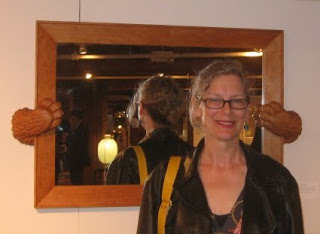
It's international Design Week in Gotham, with shows large (the International Contemporary Furniture Fair and the National Stationery Show at the Javits Center) and small (pop-ups and individual boutique & gallery appearances) all over Manhattan and Brooklyn.
Lobster & Canary was at the Friday opening of a new show, Wanted Design, at the refitted Terminal Warehouse show space at 28th & 11th in Chelsea. Sponsors include Dwell magazine, the Institut Francais, and Bang & Olufsen, with exhibitors including Ligne Roset, Objeto Brasil, Voos Furniture, Normann Copenhagen, Triode Design, Les Heritiers...and Brooklyn's own rising stars Colleen & Eric.
Colleen & Eric featured prominently the "Cowardly Lion Mirror," whose signature paws were carved by our very own Deborah A. Mills. In this case, the Lobster & Canary make no pretense of impartiality: those paws rock, and so does their creator!
For more information click here:
Deborah A. Mills Woodcarving
Colleen & Eric
Wanted Design
International Contemporary Furniture Fair
National Stationery Show Daniel A. Rabuzzi is author of the fantasy novel "The Choir Boats," available from ChiZine Publications in September 2009.
"The Choir Boats" explores issues of race, gender, sin, and salvation, and includes a mysterious letter, knuckledogs, carkodrillos, smilax root,
goat stew, and one very fierce golden cat.
(www.danielarabuzzi.com). Daniel blogs at Lobster & Canary about speculative fiction, poetry, history and the arts.
Published on May 15, 2011 09:13
May 8, 2011
Alchemically Yours (Pam Grossman; The Observatory; Visions of Golden Moons, Antimony and the Nix Alba)
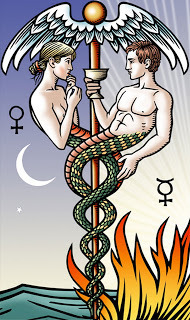
[Robert M. Place "Caduceus" detail 2011]
Lobster & Canary attended last night's thronged opening at The Observatory in Gowanus (Brooklyn) of the Pam Grossman-curated art show, Alchemically Yours. Pam-- who is also the author of Phantasmaphile (a must-read blog; if you like L & C, you will like Phantasmaphile)-- has a luscious and graceful approach, with an unswerving ability to find and juxtapose "the beautiful detail" around a common theme. We especially like her talent for calling forth depths of emotion and mystical understanding from within a small ambit: the exhibit space at The Observatory is intimate, and the works selected by Pam are like narrow apertures into half-dark worlds where suns are twinned and manticores slide silently through thickets of silver-leafed trees.
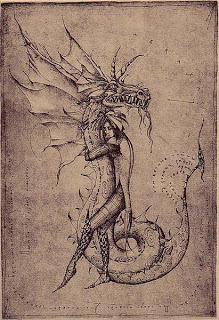
This etching-- "Abraxas" by Marina Korenfeld (2004)-- called to me from across the room. Korenfeld is a relative newcomer, most definitely a talent to watch. Her early training included puppetry, which shows in the balanced, floating quality of her figures, in their lines and ranginess (she has a series of fish drifting above people and landscapes that epitomizes her "aeriality"). She calls on East European folklore and the works of Klee, she points to Eco, Borges, Hesse and Marquez as literary influences. She says on her website: "I deeply believe that only by delving into the enigmas of the self and moving the boundaries of your knowledge, can an individual truly engage with the world and bring about change in a profound, meaningful way. These are the principles my paintings are about, symbolized in my mystical blue bird, imaginary fishes, and flying women."
Other highlights included catching up in person with Adela Leibowitz, whom L & C interviewed February 10, 2010 ("Luminous Dreamscapes"). Adela's two paintings in this show are a departure for her, being close-ups of individuals, but they glow with the same force as her more expansive work.
Molly Crabapple has a piece in the show (a sort of Elvis character with devil horns crooning to a theater full of pigs in hats), likewise Sarah Antoinette Martin (whose work always feels alchemical to me). "Old Mistress" Ann McCoy has several stunning variations on her rose-bird themes-- I love her Pfauinsel installation from 2005, the story for which begins "In the reign of the endless winter the sun was a pale memory in the heavens and dark clouds covered the palaces of the East and the West."
Alchemically Yours is self-assured, vibrant, evocative. Much good to see and feel, plus a library of works on alchemy, and the usual eccentricity of The Observatory space (Oulipo "writhing" cheek by jowl with neo-Cornellian boxes, Victorian morbidity, odd taxidermy, specimens in jars, etc.).
Runs through June 12th-- highly recommended.Daniel A. Rabuzzi is author of the fantasy novel "The Choir Boats," available from ChiZine Publications in September 2009.
"The Choir Boats" explores issues of race, gender, sin, and salvation, and includes a mysterious letter, knuckledogs, carkodrillos, smilax root,
goat stew, and one very fierce golden cat.
(www.danielarabuzzi.com). Daniel blogs at Lobster & Canary about speculative fiction, poetry, history and the arts.
Published on May 08, 2011 07:36
May 1, 2011
"Sleep No More": The Memory of Sinful Loss; The Terrible Presence of Absence
"He asked me if in fact I had not found some of the movements of the puppets (especially the smaller ones) very graceful during their dance. This conclusion I could not deny."
---Heinrich von Kleist, "On the Marionette Theater" (1810; Lobster & Canary trans.)
On Wednesday evening, we saw Sleep No More, the sold-out hit play by the U.K. troupe Punchdrunk (it opened in March this year--its initial six-week run has been extended into June). This is only the second appearance in the U.S.A. by Punchdrunk; they presented a smaller version of Sleep No More in 2009 in Boston.
Click here and here for more information.
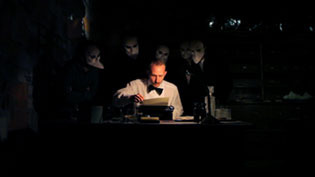
Sleep No More is an adaptation of MacBeth. True enough, but that is like saying the Empire State Building is an adaptation of Cleopatra's Needle. Sleep No More is a brilliant, interstitial phantasmagoria, an explicit homage to Hitchcock (including use of Bernard Herrman's scores), a chimera combining elements of the haunted house on the midway, the Theater of Cruelty, a designer showroom, an experimental sound concert (think DJ Spooky or John Zorn), film noir, a passion play, a pantomime, an art installation (by Anselm Kiefer, for instance, or Leonardo Drew), an interactive video game (Silent Hill comes to mind), a graphic novel drawn by Moebius, cabaret, a museum of the damned, a cabinet of curiosities.
The set is an entire building in NYC's Chelsea district, six floors with c. 90 rooms, each room meticulously and elaborately dressed, encrusted with details that are clues to the mystery of Macbeth. The audience-- each member donning a white, beaked mask as if on the Rialto, and sworn to silence-- participates in the unfolding event, with the actors embracing Grotowski's direct-engagement principles. Sleep No More is utterly immersive, in essence a massive LARP (live-action role-playing game) where the script is plastic and no one knows for certain what comes next.
We chose to wander at will through the rooms, creating multiple narratives from the mass of things presented, periodically pierced by the arc of Macbeth (the sudden eruption of a fight in front of our faces, wails and cries in the distance, a tailor or a detective sitting focused on their inscrutable work, the banquet scene viewed from the railing of an amphitheater). Here is what we experienced:
 Daniel A. Rabuzzi is author of the fantasy novel "The Choir Boats," available from ChiZine Publications in September 2009.
Daniel A. Rabuzzi is author of the fantasy novel "The Choir Boats," available from ChiZine Publications in September 2009.
"The Choir Boats" explores issues of race, gender, sin, and salvation, and includes a mysterious letter, knuckledogs, carkodrillos, smilax root,
goat stew, and one very fierce golden cat.
(www.danielarabuzzi.com). Daniel blogs at Lobster & Canary about speculative fiction, poetry, history and the arts.
---Heinrich von Kleist, "On the Marionette Theater" (1810; Lobster & Canary trans.)
On Wednesday evening, we saw Sleep No More, the sold-out hit play by the U.K. troupe Punchdrunk (it opened in March this year--its initial six-week run has been extended into June). This is only the second appearance in the U.S.A. by Punchdrunk; they presented a smaller version of Sleep No More in 2009 in Boston.
Click here and here for more information.

Sleep No More is an adaptation of MacBeth. True enough, but that is like saying the Empire State Building is an adaptation of Cleopatra's Needle. Sleep No More is a brilliant, interstitial phantasmagoria, an explicit homage to Hitchcock (including use of Bernard Herrman's scores), a chimera combining elements of the haunted house on the midway, the Theater of Cruelty, a designer showroom, an experimental sound concert (think DJ Spooky or John Zorn), film noir, a passion play, a pantomime, an art installation (by Anselm Kiefer, for instance, or Leonardo Drew), an interactive video game (Silent Hill comes to mind), a graphic novel drawn by Moebius, cabaret, a museum of the damned, a cabinet of curiosities.
The set is an entire building in NYC's Chelsea district, six floors with c. 90 rooms, each room meticulously and elaborately dressed, encrusted with details that are clues to the mystery of Macbeth. The audience-- each member donning a white, beaked mask as if on the Rialto, and sworn to silence-- participates in the unfolding event, with the actors embracing Grotowski's direct-engagement principles. Sleep No More is utterly immersive, in essence a massive LARP (live-action role-playing game) where the script is plastic and no one knows for certain what comes next.
We chose to wander at will through the rooms, creating multiple narratives from the mass of things presented, periodically pierced by the arc of Macbeth (the sudden eruption of a fight in front of our faces, wails and cries in the distance, a tailor or a detective sitting focused on their inscrutable work, the banquet scene viewed from the railing of an amphitheater). Here is what we experienced:
 Daniel A. Rabuzzi is author of the fantasy novel "The Choir Boats," available from ChiZine Publications in September 2009.
Daniel A. Rabuzzi is author of the fantasy novel "The Choir Boats," available from ChiZine Publications in September 2009."The Choir Boats" explores issues of race, gender, sin, and salvation, and includes a mysterious letter, knuckledogs, carkodrillos, smilax root,
goat stew, and one very fierce golden cat.
(www.danielarabuzzi.com). Daniel blogs at Lobster & Canary about speculative fiction, poetry, history and the arts.
Published on May 01, 2011 05:11
April 24, 2011
Back Before Babel

All languages spring from the speech of our African ancestors. Two weeks ago, Quentin Atkinson of the University of Auckland published his findings on linguistic evolution. Here's the abstract ("Phonemic Diversity Supports a Serial Founder Effect Model of Language Expansion from Africa", Science 4/15/2011):
"Human genetic and phenotypic diversity declines with distance from Africa, as predicted by a serial founder effect in which successive population bottlenecks during range expansion progressively reduce diversity, underpinning support for an African origin of modern humans. Recent work suggests that a similar founder effect may operate on human culture and language. Here I show that the number of phonemes used in a global sample of 504 languages is also clinal and fits a serial founder–effect model of expansion from an inferred origin in Africa. This result, which is not explained by more recent demographic history, local language diversity, or statistical non-independence within language families, points to parallel mechanisms shaping genetic and linguistic diversity and supports an African origin of modern human languages."Daniel A. Rabuzzi is author of the fantasy novel "The Choir Boats," available from ChiZine Publications in September 2009.
"The Choir Boats" explores issues of race, gender, sin, and salvation, and includes a mysterious letter, knuckledogs, carkodrillos, smilax root,
goat stew, and one very fierce golden cat.
(www.danielarabuzzi.com). Daniel blogs at Lobster & Canary about speculative fiction, poetry, history and the arts.
Published on April 24, 2011 04:07
April 17, 2011
Interstitial Arts Foundation: Megan Kurashige, Junot Diaz, Mores McWreath, S.J. Tucker, Cat Valente, et al.
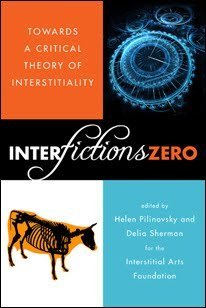

As I have blogged before, the Interstitial Arts Foundation is on the move! (Full disclosure: I am a member of the IAF's Working Group, but my contribution to the IAF's dynamism is very modest, at best.) I encourage all lobsters and canaries to check out three new developments at IAF:
1. "March Madness": 32 insightful, clever, provocative and, yes, interstitial posts-- one for each day of the month, plus a bit of lagniappe. Dance, the plastic arts, chapbooks, and much, much more...
2. (Free) Study Guide for Interfictions 2.
3. Interfictions Zero, "the rolling online anthology of interstitial criticism on interstitial texts, launched April 1 – no kidding!" Read Carlos Hernandez on Junot Diaz.Daniel A. Rabuzzi is author of the fantasy novel "The Choir Boats," available from ChiZine Publications in September 2009.
"The Choir Boats" explores issues of race, gender, sin, and salvation, and includes a mysterious letter, knuckledogs, carkodrillos, smilax root,
goat stew, and one very fierce golden cat.
(www.danielarabuzzi.com). Daniel blogs at Lobster & Canary about speculative fiction, poetry, history and the arts.
Published on April 17, 2011 02:59
April 10, 2011
The Lure of Paradise: J.T. Burke's Worlds
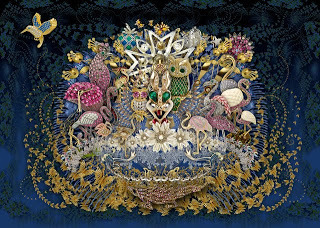
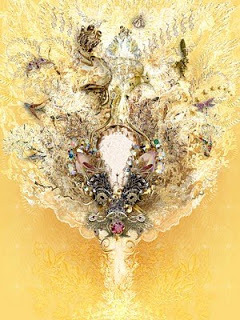
The lobster & canary encountered the worlds of J.T. Burke-- and had a chance to briefly meet the artist himself-- two weeks ago at The Artist Project show at Pier 92 in NYC. We have not stopped thinking about those worlds since.

Burke, a successful commercial/advertising photographer, turned to his art full-time in 2006. His technique is a blend of the old and the new: he scours flea markets and estate sales for jewelry and gewgaws (preferably with some wear and tear), then arranges these items into phantasmagorical landscapes, photographs the image, and finally distorts and alters the image digitally.
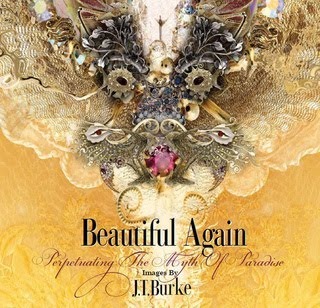
The jewelry and bric-a-brac he uses are ornate, baroque, all those animals that live as brooches on lapels, the bees and hummingbirds, the lions and tigers. Originally shiny, garish, out-sized, having now acquired a patina from use, the creatures come alive under Burke's tutelage.
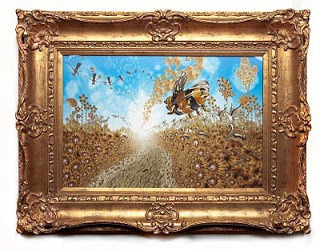
The resulting vistas swarm and seethe with strange life. They evoke rococo wall-paper and Bosch's tryptichs, psychedelic errata, the half-melted landscapes of Max Ernst, and the infinities of mandalas. They pull the viewer into their bizarre but unthreatening beauty. Bravo J.T. Burke-- click here for more on his work.Daniel A. Rabuzzi is author of the fantasy novel "The Choir Boats," available from ChiZine Publications in September 2009.
"The Choir Boats" explores issues of race, gender, sin, and salvation, and includes a mysterious letter, knuckledogs, carkodrillos, smilax root,
goat stew, and one very fierce golden cat.
(www.danielarabuzzi.com). Daniel blogs at Lobster & Canary about speculative fiction, poetry, history and the arts.
Published on April 10, 2011 04:28
April 3, 2011
Sunday Dinner in Cockayne


Why don't we feature food more centrally in speculative fiction?
I do not mean mere descriptions of food, of which the genre abounds. Hobbits are always hungry, the students at Hogwarts enjoy their butterbeer, Cugel the Clever dines on some intriguing dishes in the Dying Earth, and so on. Steven Brust, Jo Walton, and Anne McCaffrey, among others, make the food in their invented worlds something you would like to find in your neighborhood bistro.
I mean rather a focus on food as an end in itself, not as a tool to build a world or adorn an exotic setting. I want food as the central element in the plot, food as a synecdoche for the culture the author is conjuring forth, food as the means to understand the soul of the protagonist. Think the Turkish Delight with which The White Witch snares Edmund. Think Swelter's kitchen-realm in Gormenghast. "Eat me, drink me" in Wonderland.
I want the definition, preparation and delectation of food as an object of philosophy, aesthetics and desire. Food as Brillat-Savarin wrote of it, as M.F.K. Fisher wrote it, as Lidia Bastianich writes, Madhur Jaffrey, Marcella Hazan, Patricia Wells. Food as fantasy itself, not as an ingredient in a fantasy.
For a sense of what I want, check out two newish literary/philosophical magazines about food: Gastronomica and Alimentum . In their pages we live within food as Persephone tastes it in Hades, as Grendel experiences it looking in at Hrothgar's meadhall, as the banquet-goers savor it in Gabriel Axel's film Babette's Feast ("Caille en sarcophage avec sauce perigourdine"!), as the "boeuf en daube" conducts the action in To the Lighthouse, as the timbale summarizes an entire way of life in The Leopard ("The burnished gold of the crusts, the fragrance of sugar and cinnamon they exuded, were but preludes to the delights released from the interior when the knife broke the crust," in Archibald Colquhoun's translation).

 Daniel A. Rabuzzi is author of the fantasy novel "The Choir Boats," available from ChiZine Publications in September 2009.
Daniel A. Rabuzzi is author of the fantasy novel "The Choir Boats," available from ChiZine Publications in September 2009."The Choir Boats" explores issues of race, gender, sin, and salvation, and includes a mysterious letter, knuckledogs, carkodrillos, smilax root,
goat stew, and one very fierce golden cat.
(www.danielarabuzzi.com). Daniel blogs at Lobster & Canary about speculative fiction, poetry, history and the arts.
Published on April 03, 2011 04:02
March 27, 2011
Singing Together in the Boundless Night (Rusty Schweickart; Dave Matthews; Robert Randolph)
Rusty Schweickart came back from the Apollo 9 mission in 1969 with a profoundly altered sense of relationship with our planet. As he later wrote about circling Earth every 90 minutes ( click here for more):
"And the contrast between that bright blue and white Christmas tree ornament and the black sky, that infinite universe, really comes through, and the size of it, the significance of it. It is so small and so fragile and such a precious little spot in the universe that you can block it out with your thumb. And you realize that on that small spot, that little blue and white thing, is everything that means anything to you - all love, tears, joy, games, all of it on that little spot out there that you can cover with your thumb. And you realize from that perspective that you've changed, that there's something new there, that the relationship is no longer what it was."
So what do we do on our tiny island in the midst of the endless sea?
We sing and we dance, like Tolkien's elves under the stars, like the inhabitants of Le Guin's Earthsea every New Year. Together, weaving from our individual solitudes a chorus to defy the night, bonding ourselves to ourselves with inimitable rhythms.
Like this (with thanks to the Dave Matthews Band, and to Robert Randolph & The Family Band respectively):
Daniel A. Rabuzzi is author of the fantasy novel "The Choir Boats," available from ChiZine Publications in September 2009.
"The Choir Boats" explores issues of race, gender, sin, and salvation, and includes a mysterious letter, knuckledogs, carkodrillos, smilax root,
goat stew, and one very fierce golden cat.
(www.danielarabuzzi.com). Daniel blogs at Lobster & Canary about speculative fiction, poetry, history and the arts.
Published on March 27, 2011 04:45
March 20, 2011
H.P. Lovecraft and the Language of Nuclear Meltdown
Lovecraft's prose is empurpled, histrionic, so over the top that it is therefore perfect for capturing what he sought to capture: the immensities of time and space (especially as compared to our fragile and foreshortened human vistas), the menace of unknowable things lurking in deep places, the folly of dabbling in arcana beyond our ken, the indifference of the universe to the fate of humankind.
The lobster & canary were reminded of how apposite Lovecraftian prose can be while reading the newspaper this Sunday morning. The lead story in the "Week in Review" section of the New York Times is "Lessons from Chernobyl for Japan" by Ellen Barry. (Click here for the full story.) Of course, I am not saying that Ms. Barry has consciously adopted Lovecraftian language to describe the ongoing travails of Chernobyl; she may never have read Lovecraft, for all we know. The point is that some events defy our sense of scale and mock our ability to respond, pushing us to linguistic extremes in our attempts to describe-- with Beckett perhaps representing the absurdist, stripped-down end of the spectrum, and Lovecraft the fevered, rococo opposite. And just as Beckett's mode is part of our linguistic armory-- even for writers who may have never read End Game-- Lovecraft's idiom is likewise a part of our shared toolkit.
From one of the first paragraphs in Barry's report:
"Water cannot be allowed to touch the thing that is deep inside the reactor: about 200 tons of melted nuclear fuel and debris, which burned through the floor and hardened, in one spot, into the shape of an elephant's foot. This mass remains so highly radioactive that scientists cannot approach it."
These lines could be straight out of "The Dunwich Horror," The Shadow out of Time, or At the Mountains of Madness.
Making this passage all the more eldritch (to use a word so favored by the Gentleman from Providence), the workers at Chernobyl call the structure enveloping the reactor "the sarcophagus."
As Barry notes, a nuclear meltdown "is a problem that does not exist on a human time frame." We are here confronting the mind-breaking trajectories Lovecraft laid out in, for instance, "The Whisperer in Darkness" and "The Color out of Space."
Barry evokes the eerie emptiness of the deserted bedroom community for Chernobyl's workers:
"... wallpaper has slipped down under its own weight and paint has peeled away from apartment walls in fat curls. Ice glazes the interiors. On a residential street, where Soviet housing blocks tower in every direction, it is quiet enough to hear the sound of individual leaves brushing against branches.
The wild world is gradually pressing its way in...[...] ...wild boars and foxes had begun to take shelter in the abandoned city..."
Echoes here of Lovecraft's decaying town of Innsmouth, with a deformed secret at its core, and of other ruins populating his work.
So there dwells a monstrous mass within its hastily erected tomb at Chernobyl, and we face a similar entombment possibly at Fukushima. Like the inhuman Cthulhu dreaming in his stone house, a force manifesting on planes outside those humans readily grasp. Cthulhu, central figure of the Lovecraftian Mythos, whose half-life dwarfs our understanding. As Lovecraft put it, in one of his most famous lines:
"That is not dead which can eternal lie.
And with strange aeons even death may die."Daniel A. Rabuzzi is author of the fantasy novel "The Choir Boats," available from ChiZine Publications in September 2009.
"The Choir Boats" explores issues of race, gender, sin, and salvation, and includes a mysterious letter, knuckledogs, carkodrillos, smilax root,
goat stew, and one very fierce golden cat.
(www.danielarabuzzi.com). Daniel blogs at Lobster & Canary about speculative fiction, poetry, history and the arts.
The lobster & canary were reminded of how apposite Lovecraftian prose can be while reading the newspaper this Sunday morning. The lead story in the "Week in Review" section of the New York Times is "Lessons from Chernobyl for Japan" by Ellen Barry. (Click here for the full story.) Of course, I am not saying that Ms. Barry has consciously adopted Lovecraftian language to describe the ongoing travails of Chernobyl; she may never have read Lovecraft, for all we know. The point is that some events defy our sense of scale and mock our ability to respond, pushing us to linguistic extremes in our attempts to describe-- with Beckett perhaps representing the absurdist, stripped-down end of the spectrum, and Lovecraft the fevered, rococo opposite. And just as Beckett's mode is part of our linguistic armory-- even for writers who may have never read End Game-- Lovecraft's idiom is likewise a part of our shared toolkit.
From one of the first paragraphs in Barry's report:
"Water cannot be allowed to touch the thing that is deep inside the reactor: about 200 tons of melted nuclear fuel and debris, which burned through the floor and hardened, in one spot, into the shape of an elephant's foot. This mass remains so highly radioactive that scientists cannot approach it."
These lines could be straight out of "The Dunwich Horror," The Shadow out of Time, or At the Mountains of Madness.
Making this passage all the more eldritch (to use a word so favored by the Gentleman from Providence), the workers at Chernobyl call the structure enveloping the reactor "the sarcophagus."
As Barry notes, a nuclear meltdown "is a problem that does not exist on a human time frame." We are here confronting the mind-breaking trajectories Lovecraft laid out in, for instance, "The Whisperer in Darkness" and "The Color out of Space."
Barry evokes the eerie emptiness of the deserted bedroom community for Chernobyl's workers:
"... wallpaper has slipped down under its own weight and paint has peeled away from apartment walls in fat curls. Ice glazes the interiors. On a residential street, where Soviet housing blocks tower in every direction, it is quiet enough to hear the sound of individual leaves brushing against branches.
The wild world is gradually pressing its way in...[...] ...wild boars and foxes had begun to take shelter in the abandoned city..."
Echoes here of Lovecraft's decaying town of Innsmouth, with a deformed secret at its core, and of other ruins populating his work.
So there dwells a monstrous mass within its hastily erected tomb at Chernobyl, and we face a similar entombment possibly at Fukushima. Like the inhuman Cthulhu dreaming in his stone house, a force manifesting on planes outside those humans readily grasp. Cthulhu, central figure of the Lovecraftian Mythos, whose half-life dwarfs our understanding. As Lovecraft put it, in one of his most famous lines:
"That is not dead which can eternal lie.
And with strange aeons even death may die."Daniel A. Rabuzzi is author of the fantasy novel "The Choir Boats," available from ChiZine Publications in September 2009.
"The Choir Boats" explores issues of race, gender, sin, and salvation, and includes a mysterious letter, knuckledogs, carkodrillos, smilax root,
goat stew, and one very fierce golden cat.
(www.danielarabuzzi.com). Daniel blogs at Lobster & Canary about speculative fiction, poetry, history and the arts.
Published on March 20, 2011 07:26
March 13, 2011
Interstitial Arts Foundation "March Madness"; The Witches of Lublin (Ellen Kushner, Tovah Feldshuh, Neil Gaiman)
First, the lobster and the canary thank all of you who sent comments about last week's posting (on fairy tales, film, and income inequality). Besides the three comments posted here, we received sixteen equally positive and insightful notes from readers via e-mail...making the post the most widely commented upon in our history. Special thanks to Terry Weyna and Chris Nakashima Brown for blogging and/or tweeting about the post.
Meanwhile, the canary is tweeting and the lobster is making whatever sounds lobsters make about two really exciting events:
"MARCH MADNESS"---no, not that one, but the one over at the Interstitial Arts Foundation (disclosure: I am an IAF working group member). Every day this month the IAF is posting a review, or an interview, or other commentary on Things Interstitial. Click here to check out some of the smartest discussion on the Web about art that crosses, erases, ignores or just plain confounds genre boundaries. (How do you spell "unclassifiable" in Klingon? in Sindarin?).
There you will find, inter alia, Erin Underwood's review of the Indy Convergence, and her interview with Nicole Kornher-Stace (whose poetry I have praised here at L & C), Mike Allen on "jubilant irreverence" (an interview with Brian Counihan, founder of the Marginal Arts Festival), and Ellen Kushner commenting on Michael Swanwick's discussion of T.H. White.
Speaking of Ellen Kushner, the other event L & C highlights over this morning's coffee is the audio drama The Witches of Lublin . Co-written by Kushner, with Elizabeth Schwartz and Yale Strom, with music by Strom, and directed & produced by Sue Zizza, The Witches of Lublin is a 59-minute story based (per their website) "on Jewish women's lives in eighteenth century Europe, klezmer music, and feminist history, with a healthy dose of magical realism thrown in." What a wonderful brew!
Click here for details.
It gets even better: Tovah Feldshuh and Neil Gaiman have roles in the production. Oh lovely, sings the canary; lobster claps claws. The Witches is available for airing, starting in April-- just in time for Passover.
Can't hardly wait.Daniel A. Rabuzzi is author of the fantasy novel "The Choir Boats," available from ChiZine Publications in September 2009.
"The Choir Boats" explores issues of race, gender, sin, and salvation, and includes a mysterious letter, knuckledogs, carkodrillos, smilax root,
goat stew, and one very fierce golden cat.
(www.danielarabuzzi.com). Daniel blogs at Lobster & Canary about speculative fiction, poetry, history and the arts.
Meanwhile, the canary is tweeting and the lobster is making whatever sounds lobsters make about two really exciting events:
"MARCH MADNESS"---no, not that one, but the one over at the Interstitial Arts Foundation (disclosure: I am an IAF working group member). Every day this month the IAF is posting a review, or an interview, or other commentary on Things Interstitial. Click here to check out some of the smartest discussion on the Web about art that crosses, erases, ignores or just plain confounds genre boundaries. (How do you spell "unclassifiable" in Klingon? in Sindarin?).
There you will find, inter alia, Erin Underwood's review of the Indy Convergence, and her interview with Nicole Kornher-Stace (whose poetry I have praised here at L & C), Mike Allen on "jubilant irreverence" (an interview with Brian Counihan, founder of the Marginal Arts Festival), and Ellen Kushner commenting on Michael Swanwick's discussion of T.H. White.
Speaking of Ellen Kushner, the other event L & C highlights over this morning's coffee is the audio drama The Witches of Lublin . Co-written by Kushner, with Elizabeth Schwartz and Yale Strom, with music by Strom, and directed & produced by Sue Zizza, The Witches of Lublin is a 59-minute story based (per their website) "on Jewish women's lives in eighteenth century Europe, klezmer music, and feminist history, with a healthy dose of magical realism thrown in." What a wonderful brew!
Click here for details.
It gets even better: Tovah Feldshuh and Neil Gaiman have roles in the production. Oh lovely, sings the canary; lobster claps claws. The Witches is available for airing, starting in April-- just in time for Passover.
Can't hardly wait.Daniel A. Rabuzzi is author of the fantasy novel "The Choir Boats," available from ChiZine Publications in September 2009.
"The Choir Boats" explores issues of race, gender, sin, and salvation, and includes a mysterious letter, knuckledogs, carkodrillos, smilax root,
goat stew, and one very fierce golden cat.
(www.danielarabuzzi.com). Daniel blogs at Lobster & Canary about speculative fiction, poetry, history and the arts.
Published on March 13, 2011 08:45



